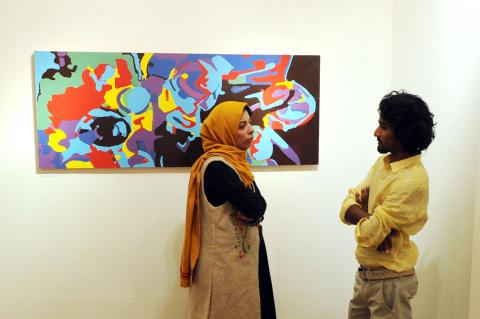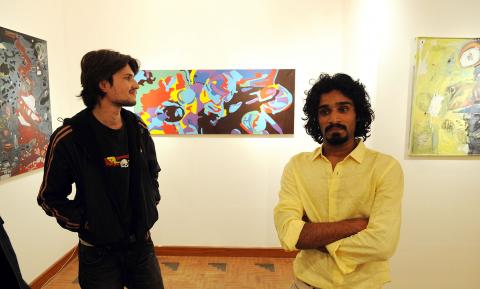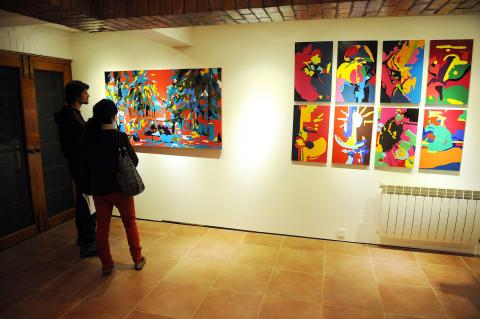It may not seem the most obvious setting, but a squat building overlooking a slum is home to one of Pakistan’s leading galleries, which for 30 years has defied dictatorships and fundamentalists to champion cutting-edge art.
Rohtas Gallery was founded in 1981, at the height of military ruler General Zia-ul-Haq’s martial law, as Pakistan was undergoing a program of Islamization that imposed Draconian restrictions on culture and entertainment.
With all but the most insipid forms of visual art officially banned as “un-Islamic,” architect Naeem Pasha and a group of friends decided Pakistan’s artists needed a space to express themselves freely.

Photo: AFP
“Abstract art was un-Islamic,” Pasha told AFP.
“Calligraphy, landscape without even a crow or a goat or anything living in it, insipid crayon portraits of your gardener that the expatriates would take home and say ‘this is what Pakistanis look like’ — they were allowed. But we did what we had to do, and we showed nudes, we showed abstracts, we showed everything,” Pasha said.
Maintaining the gallery’s commitment to showing progressive art meant a delicate game of cat-and-mouse with Zia’s powerful intelligence agencies — and taking advantage of Cold War rivalries.

Photo: AFP
Diplomats would vie with each other for invitations to exhibition openings at Rohtas’ tiny original venue.
“The American ambassador would make sure he came before the Soviet ambassador and the Soviet ambassador would try to beat him to it because they wanted to show they supported art,” Pasha explained.
“Zia-ul-Haq always gave you the impression he was very magnanimous and non-interfering — at least that’s the impression he wanted to give to the diplomats, so they didn’t touch us.”

Photo: AFP
But the secret police came calling after a picture appeared in a newspaper of the Soviet ambassador at an exhibition next to the drawing of a tailor’s dummy wearing a general’s uniform with a snake coming out of the sleeve.
After a tip-off from a friend in the Inter-Services Intelligence agency, Pasha rushed to the gallery to take down the pictures — which the newspaper article said had all been sold.
“Sure enough by 11, 12, o’clock these people came and they said ‘where are these pictures?’” said Pasha.
“So I said ‘Well, you saw it in the newspapers, they’re sold, they’re gone.’ Usually if somebody buys the picture will stay on the wall for a month.”
Rohtas helped launch the careers of many of the biggest names in modern Pakistani art, including Quddus Mirza, Rashid Rana and Irfan Qureshi, who has been named artist of 2013 by Berlin’s Deutsche Bank Kunsthalle.
Pasha said the censorship of the Zia-era acted as an inspiration to artists.
“Fascism becomes an instrument by default to make good art happen,” he said.
“It is against that repression that the artist woke up and today what you see in Pakistani art — the breeding ground was in that 1980s martial law.”
Mirza, who curated a show celebrating Rohtas’ 30th birthday in October, said the gallery had encouraged artists to follow their creative impulses free not only from political restrictions, but also commercial pressures.
“Installation or sculpture or digital prints at one time were not sold. When you have that kind of show, it’s not going to be beneficial commercially but Rohtas supported it,” he said.
“I think that role was important — it supported young artists and artists who were not given the chance anywhere else. If there’s no place to show you amend, you censor, you clip your vision. In that way it was very important,” Mirza said.
Demand for contemporary art among collectors in Pakistan is growing, particularly among the young, Pasha says, but shows sell 25 percent of the exhibits at most.
His architecture practice supports the gallery financially and Pasha said he was proud to have been able to maintain its commitment to progressive art without watering it down with more commercially friendly pieces.
“We knew the type of art that we wanted to show, which is not economically viable, if our architecture practice doesn’t subsidize it, it will not last,” he said.
“So it’s more madness, indulgence, a commitment that this is something that one must do. That’s how we survived and we still do.
“If we were going to be commercial maybe we would have changed direction and not shown art of this caliber, mixed it with folk and trinkets and all this.”
The overt oppression of Zia’s rule has long gone, but Pakistan remains a deeply conservative country where religious extremists seek to impose limits on culture.
Pasha says the fundamentalist religious movements are now inspiring artists.
“Now we have got another fuel to make art which is the ‘fundo’ label and the ‘terror’ label,” he said.
“A lot of work you see is coming out and in one kind or another it represents that.”
Qadir Jhatial, 26, whose debut exhibition opened recently at Rohtas, said a show at the venerable gallery was something to which all young artists aspired.
“Rohtas is really supporting young talent,” he told AFP. “In Pakistan definitely I will get good exposure, people will get to know my work.”

In the March 9 edition of the Taipei Times a piece by Ninon Godefroy ran with the headine “The quiet, gentle rhythm of Taiwan.” It started with the line “Taiwan is a small, humble place. There is no Eiffel Tower, no pyramids — no singular attraction that draws the world’s attention.” I laughed out loud at that. This was out of no disrespect for the author or the piece, which made some interesting analogies and good points about how both Din Tai Fung’s and Taiwan Semiconductor Manufacturing Co’s (TSMC, 台積電) meticulous attention to detail and quality are not quite up to

April 21 to April 27 Hsieh Er’s (謝娥) political fortunes were rising fast after she got out of jail and joined the Chinese Nationalist Party (KMT) in December 1945. Not only did she hold key positions in various committees, she was elected the only woman on the Taipei City Council and headed to Nanjing in 1946 as the sole Taiwanese female representative to the National Constituent Assembly. With the support of first lady Soong May-ling (宋美齡), she started the Taipei Women’s Association and Taiwan Provincial Women’s Association, where she

Chinese Nationalist Party (KMT) Chairman Eric Chu (朱立倫) hatched a bold plan to charge forward and seize the initiative when he held a protest in front of the Taipei City Prosecutors’ Office. Though risky, because illegal, its success would help tackle at least six problems facing both himself and the KMT. What he did not see coming was Taipei Mayor Chiang Wan-an (將萬安) tripping him up out of the gate. In spite of Chu being the most consequential and successful KMT chairman since the early 2010s — arguably saving the party from financial ruin and restoring its electoral viability —

It is one of the more remarkable facts of Taiwan history that it was never occupied or claimed by any of the numerous kingdoms of southern China — Han or otherwise — that lay just across the water from it. None of their brilliant ministers ever discovered that Taiwan was a “core interest” of the state whose annexation was “inevitable.” As Paul Kua notes in an excellent monograph laying out how the Portuguese gave Taiwan the name “Formosa,” the first Europeans to express an interest in occupying Taiwan were the Spanish. Tonio Andrade in his seminal work, How Taiwan Became Chinese,